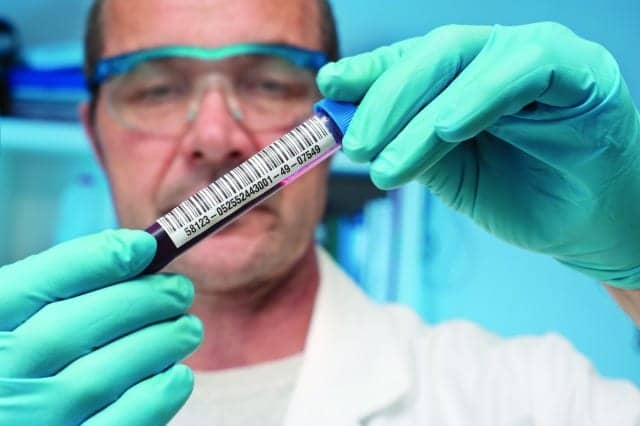Safety in clinical labs not top of mind despite history of lab accidents
By Gary Tufel
You’d think safety would be a top concern for clinical labs. But that isn’t the case, according to Jim Kaufman, PhD, director, and Christina Dillard, assistant director, of the Laboratory Safety Institute (LSI), Natick, Mass. LSI lists more than 400 laboratorians who have died in the past 100+ years as the result of lab accidents in a “Memorial Wall” on its website. Kaufman cites the results of a questionnaire that appeared in the January 2, 2013, issue of Nature. In that article, “Safety Survey Reveals Lab Risks – Questionnaire,” author Richard Van Noorden stated that scientists may have a false sense of security about the safety of their laboratories, according to early results from the first international survey of researchers’ workplace attitudes and practices.
[reference float=”right”]OSHA Changes Up
OSHA revised its Hazard Communication Standard (HCS) to align with the GHS and published it in the Federal Register in March 2012 (77 FR 17574). Two significant changes contained in the revised standard require the use of new labeling elements and a standardized format for Safety Data Sheets (SDSs), formerly known as Material Safety Data Sheets (MSDSs).
The new label elements and SDS requirements will improve worker understanding of the hazards associated with the chemicals in their workplace. To help companies comply with the revised standard, OSHA is phasing in the specific requirements over several years (December 1, 2013, to June 1, 2016).[/reference]
Van Noorden wrote that some 86% of the roughly 2,400 scientists who responded said that they believe their labs are safe places to work. Yet just under half had experienced injuries ranging from animal bites to chemical inhalation, and many experienced frequent lone working, unreported injuries, and insufficient safety training on specific hazards. This is especially troubling considering that there have long been safety standards in place for labs, going back to the Occupational Safety and Health Administration’s (OSHA) 1983 Hazardous Communication Standard, Kaufman says. That standard was superseded in 1990 with the promulgation of the Laboratory Standard to regulate exposure to hazardous chemicals in labs.
So why aren’t lab accidents largely a thing of the past? Kaufman notes that a recent Government Accounting Office study found that 30% of employers who dealt with hazardous chemicals were in full compliance with the OSHA Hazard Communication Standard (HCS), 50% were partially compliant, and 20% had done nothing to achieve compliance. (The standard requires employers to identify workplace chemical hazards and communicate that information to their employees.) Dillard says that many accidents are due to the repetitive nature of the jobs many laboratorians perform, which can lead to boredom, inattention, and a greater possibility of accidents.
(For more information, see our sidebar, Mitigate Safety Risks in Labs with Barcode Labeling Software.)
What else should clinical laboratorians watch out for? Some other concerns involve bioterrorism, weaponized biological agents, and highly infectious and deadly viruses. Dillard says much of the risk in labs is biological, which is something clinical labs don’t normally deal with, but infected blood could be an element of danger, and she cites an incident in which Marburg virus got out of a German lab and infected and killed several people. Biohazardous waste, disinfectants, and spill containment are all safety issues. “And careless and sloppy lab work can cause accidents,” Dillard says. In addition, protective lab coats, gloves, eyewear and face protection, and eyewash and showers are all devices that can avert accidents if used—which they sometimes are not.
CLINICAL LABS ARE NOT PREPARED TO HANDLE INFECTIONS
The Chemical Facility Anti-Terrorism (CFAT) Standard provides labs with a list of more than 300 dangerous chemicals, which if present in regulated quantities, require special security precautions. How concerned should clinical labs doing routine testing of samples be? Dillard notes that LSI has done work for a Canadian company that does blood testing for many companies. In those cases, “If someone being tested is very sick, their sample could be very problematic. For example, if such diseases as anthrax and Ebola are present, and a safety breach occurs, it could potentially be disastrous.”
She adds that other LSI clients may not follow hospital rules but still must be state-certified. But if such labs are not focused on safety, when blood and urine samples are infected, these labs may not be prepared to handle it. There may not be clear designations of where laboratorians should eat or how to store samples.
For clinical labs, biological warfare is not much of a concern, Dillard says, and studies had never ranked clinical labs as having high rates of infections. However, more recent studies have shown higher infection rates, but clinical labs aren’t prepared to handle infections.
“Being a clinician in these labs is not a highly skilled position, only requiring a low-level knowledge of epidemiology. Basically, these techs take a sample, put it on a well plate, and place it into a machine. They don’t make a connection with the need for masks and proper safety apparel. The job is so mundane, the laboratorians are lulled into a false sense of security,” Dillard says.
In blood and urine labs, she says, “standards are still marginally OK. Changes will happen if new diseases emerge, as happened with the West Nile virus, Eastern Equine Encephalitis virus, etc. We must ensure that there’s a minimum of contamination. But although there are concerns, incidents have been isolated to those samples that go to specific labs. Clinical labs, although they do test a wide variety of samples, don’t require a biosafety level of 4—they are, instead, level 2.”
Still, incidents do happen, like the LSI client who processed a sample from a sea life specimen from Japan that had been radiated in the Fukushima nuclear accident in Japan. “These are unknowns, and labs don’t know if this could infect people or is limited to animals. How do you process or dispose of it? For clinical labs that do the same sort of specimens over and over, it’s hard to be prepared for these things,” Dillard says. “You hope they follow good protocols and procedures so you’re not infected,” Kaufman adds. And Dillard cautions that although this situation is highly unusual, straight blood and urine processing is still so mundane that when one sample outside their scope comes along, they are not prepared. “It’s hard for them to stay focused, and automation has exacerbated the problem; mechanization has made the process even more hands-off and boring,” she says.
Another client is an example of a different safety problem. This company manufactures micro pumps for analyzers, Kaufman says. When one breaks down and is sent for repair, the tech who fixes it has no idea if it has been cleaned properly, opening up the possibility that the pump contains contaminated material from the samples it has been used on. Further, says Dillard, these techs are often not given clear notice that they may also be at risk from the air they use to clean the machines, which could aerosolize contaminated material contained within them.
Communication must improve, she says, and that includes IT personnel who service lab computers. Are they informed? Are they wearing gloves? Could the computers infect the workshops where repairs are performed, which are not as well-ventilated as labs and use canned air? And are the techs themselves clean enough to not contaminate computers and lab devices?
Kaufman notes that The Joint Commission accredits and certifies more than 20,000 healthcare organizations and programs in the United States. The inspections and accreditation are, however, voluntary. Still, he says, some are conducting more training. Clinical labs are mandated to conduct annual training on blood-borne pathogens, but Dillard notes that the training is often not adequate and only offers bare-bones instruction. “Safety and safety training has taken the role of being a roadblock to getting work done, not getting work done better,” she says.
Some design changes have been made to enhance safety. Kaufman points out that fixed caps on eyewash fountains have been replaced by hinged caps, reducing spillage. And eyepieces have been redesigned to fit better and not slip off. Dillard says wall-mounted syringe disposals have been an improvement, but Kaufman notes that closed biosafety containers, while an improvement, are not always closed. “I once saw someone in a lab throwing samples at an open container,” he says. Dillard also says that there’s too much reliance on UV lights to clean up solid samples. “There’s a difference between laminar flow hoods and biosafety cabinets. Laminar flow sends unfiltered air directly at the tech and into the lab. Laboratorians don’t appreciate the difference between the two, and there’ve been no major changes in that area,” she says.
She also says that in sharps disposal, Stericycle is the industry leader. “That could be for better or for worse, but at least it’s consistent because every lab uses their products,” Dillard says. (For more information on laboratory safety products, visit our Product Roundup sidebar.)
It’s hard to fathom why lab safety seems to be a secondary priority at best, but Kaufman says what happened in October 2012, when an outbreak of fungal meningitis due to fungal contamination of medication used for epidural steroid injections packaged and marketed by the New England Compounding Center (NECC), a compounding pharmacy in Framingham, Mass, caused the deaths of about 75 people and necessitated 720 be treated for persistent fungal infections, should be enough to make safety a top priority; that, and a look at the “Memorial Wall” on the LSI website.
Readers are welcome to request a free copy of LSI’s “Laboratory Safety Guideline” or download copies from the LSI website. More than four million free copies (in 11 languages) have been distributed.
For more information on laboratory safety, read our interview with Daniel J. Scungio, known to his customers as “Dan the Lab Safety Man.”
Gary Tufel is a contributing writer for CLP. For further information, contact chief editor Steve Halasey at [email protected].






